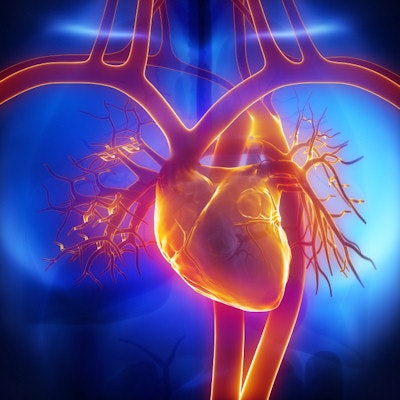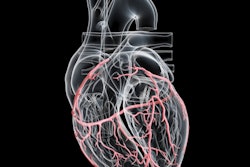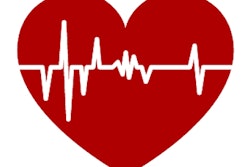
If CT scans detect any amount of coronary artery calcium in people between the ages of 32 and 46 years, they have an exponentially higher risk of cardiovascular events and death later in life, according to a February 8 paper in JAMA Cardiology. Developing a screening strategy for younger people at risk should be a priority.
Researchers from Vanderbilt University followed more than 3,000 individuals ages 18 to 30 in the Coronary Artery Risk Development in Young Adults (CARDIA) study for a mean 13 years after performing coronary artery calcium (CAC) scoring with CT. They found that having any coronary calcium at CT was associated with a fivefold increase in coronary events in later years, and a threefold increase in any cardiovascular events.
What's more, even the lowest CAC scores boosted the risk of events by 2.6-fold compared to having no calcium, with overall results suggesting that CT would make a good screening tool among those at higher risk of coronary heart disease (CHD) (JAMA Cardiology, February 8, 2017). Moreover, the association of CAC with CHD strengthened as the burden of calcified plaque increased.
"Any measurable CAC in early middle age, even scores < 100, indicates significant risk of acute myocardial infarction, both fatal and nonfatal, over the next decade beyond standard risk factors, and identifies an individual at particularly elevated risk for CHD, for whom aggressive prevention is likely warranted," lead author Dr. John Carr told AuntMinnie.com via email.
The results support the potential use of CAC as a biomarker for risk of CHD and premature death in young adults, he concluded, along with co-author David Jacobs, PhD, and colleagues.
"Practically, this means that radiologists need to simply report the presence of CAC so the individual and their healthcare providers can then evaluate their risk factors and determine a risk reduction strategy," Carr said. "The person does not need a dedicated CAC CT scan or calculation of an Agatston score. This change in clinical practice can be implemented immediately without additional CT scans by simply reporting CAC as an important biomarker of risk in the impression of reports."
Better assessment needed
The CARDIA study, from which this study's cohort was selected, previously reported that nonoptimal levels of modifiable cardiovascular risk factors at a mean age of 25 years were associated with the presence of CAC at age 40. But it remains unknown whether the presence of CAC in those in their 30s and early 40s is associated with clinical events occurring by the age of 58.
"We hypothesized that the presence of CAC among individuals aged 32 to 46 years would be associated with clinical CHD and [cardiovascular disease (CVD)] occurring by the age of 58 years," Carr and colleagues wrote. The researchers also examined whether early clinical risk factors were associated with the development of CAC and whether such factors supported a selective screening strategy for CAC.
Incident coronary heart disease was defined as fatal or nonfatal myocardial infarction, acute coronary syndrome without myocardial infarction, coronary revascularization, or CHD death. Incident cardiovascular disease included CHD, stroke, heart failure, and peripheral arterial disease. Death included all causes. The probability of developing CAC by age 32 to 56 years was assessed using clinical risk factors measured seven years apart between the ages of 18 and 38.
Events increase with CAC
The 30-year study included 3,043 participants (1,383 men, 1,660 women) with a mean age of 40.3 years. By year 15, the investigators found 309 individuals (10.2%) with the presence of coronary artery calcium at any level, with a geometric mean Agatston score of 21.6. After a mean follow-up of 12.5 years, they found 57 incident CHD events and 108 incident CVD events.
The number of events increased across the clinical CAC ranges. After adjusting for differences in demographics, risk factors, and treatments, individuals with any coronary artery calcium saw a fivefold increase in CHD events, with a hazard ratio (HR) of 5.0 (95% confidence interval [CI]: 2.8-8.7), and a threefold increase in CVD events (HR 3.0; 95% CI: 1.0-5.7). Of the deaths in the individuals with CAC scores higher than 100, 77% were considered to be related to CHD events.
| CHD events and deaths by CAC score | |||
| CAC score 1-19 | CAC score 20-99 | CAC score 100 or higher | |
| Incidence of CHD events per 100 individuals | 4.8 events | 10.6 events | 26.1 events |
| All-cause deaths per 100 individuals | 5.3 deaths | 4.0 deaths | 22.4 deaths |
Despite the results, more study is needed before adopting routine CT screening for individuals at elevated risk, according to Carr.
"A dedicated screening program for CAC in middle-age adults is a complex balancing of risk and benefits to the individual and society requiring more study," he told AuntMinnie.com. "However, standard reporting of incidentally noted CAC from CT scans of the chest coupled with more aggressive implementation of proven CVD risk-factor reduction strategies may enhance CVD prevention without additional testing using currently available information."
That means reporting as a risk biomarker the calcifications that clinicians already see routinely on even nondedicated and nongated CT scans.
"This change in clinical practice can be implemented immediately without additional CT scans by simply reporting CAC as an important biomarker of risk in the impression of reports," Carr said. "This awareness and reporting by the radiology community will provide these individuals with important information about their near-term CHD/CVD risk and then [allow them to take] proven steps to reduce their CVD risk factors with their healthcare providers."
Strengths of the study included its large cohort and prospective longitudinal design over 30 years, its community-based biracial population, and the use of U.S. Food and Drug Administration-approved software for measuring coronary calcium. The relatively small number of events is a limitation, but the authors said they plan more follow-up.
An accompanying editorial by Dr. Ron Blankstein from Brigham and Women's Hospital and Dr. Philip Greenland from Northwestern University noted there is no evidence as of yet that beginning statin therapy at an early age leads to better outcomes. However, they agreed with the authors that paying attention to calcium seen on CT scans of younger individuals is an important mission and should be undertaken immediately.
"These results definitely have implications for managing young individuals who are found to have CAC on results of other tests" such as chest CT scans, Blankstein and Greenland wrote. The results also underscore the significance of prevention, which is supported by prior data from the CARDIA study showing that having optimal risk factors in young adults is associated with a markedly lower risk of having incident CAC 15 years later.




















